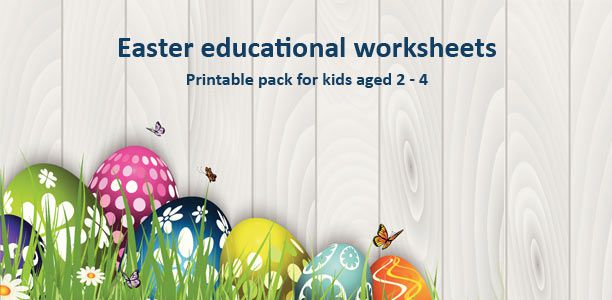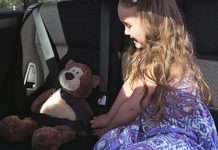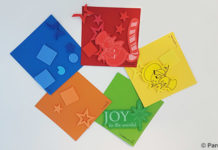Age
2-4 years
Duration of activity
A single worksheet can be completed in about 10 minutes. However you can extend the time by asking your child lots of questions about the worksheets as you go.
Materials/equipment
- Printable Easter educational worksheets
- Coloured pencils or felt pens
- Laminating machine and laminating pouches (optional- for re-usable worksheets)
- Multipurpose spray and a cloth for wiping clean laminated worksheets
- A flat surface where your child can write
Cost
The worksheets cost very little to print out and you’ll probably already have coloured pencils or felt pens in your child’s activity box.
Making the worksheets re-useable
If you want to laminate the worksheets to make them re-usable, you can buy a $20 laminator and plastic laminating sheets (pack of 50 for about $8) from a stationary store e.g. Officeworks. But laminating will save lots of money in the long run because you can use the same worksheet over and over again, even store and use for the next sibling when your first child has outgrown them.
Preparation
- Print the worksheets you would like to use – you could print the entire set of worksheets, or let your child pick one or more that they would like to do.
- If you wish to laminate some of the worksheets (e.g. the ones that print out in colour), put each worksheet you want to laminate into a separate pouch and pass it through the laminator to seal. (You will need to use washable textas to write on these and a spray and wipe solution with an old rag to clean them after use).
- Set up the worksheets and coloured pencils on a flat surface that’s appropriate for your child’s height. A child size desk is perfect.
What to do
Activity 1- Tracing the Easter Egg
- Look at the worksheet and talk about the Easter eggs, for example that there are four eggs and two are big and two are small. Discuss the shape of the eggs and how they are different to Easter eggs (e.g. they are not nice and colo
 urful like Easter eggs).
urful like Easter eggs).- Explain to your child that they need to trace around the dotted lines then colour them in to turn the egg outlines into Easter eggs.
- Tell your child to start by tracing around the first (left-most) egg on the worksheet. Encourage them to try and keep their pencil down on the paper from the time they start tracing until they have traced the entire outline. However, for y
ounger children who are just starting to develop their writing skills, this will be too challenging. They will probably need to lift their pen or pencil several times, especially when tracing the big eggs. - Instruct your child to colour each egg to make it look like an Easter egg. Encourage them to use different colours for each egg or different sections of the same egg or to draw the patterns they have spoken about.
Activity 2- Easter count the pictures
- Each row of the worksheet has a different number of Easter pictures. Your child needs to count the pictures and record how many are in each row.
- Read the instructions on the worksheet. Point to the words while reading to help your child understand that what you say is what is written on the page. Make sure they understand the instructions and explain further if you need to by telling them that on each row they need to count all the pictures.
- Start by asking your child to count the pictures in the first row. Encourage them to start at the left and work to the right as they count. Help them to count if they are not yet old enough to do it themselves.
- When your child has counted the pictures, get them to complete the how many pictures section. The first row is completed as an example.
- There are two squares in each row. Tell your child that the first square is where they draw a dot for each picture in the row and they need to draw the same number of dots as there are pictures.
- The second square is where they write the numeral that corresponds to how many pictures there are. Use number flashcards to help them identify the numeral if they are having trouble.
- Repeat until your child has finished all the rows.
Activity 3- Easter matching worksheets
- There are five worksheets in this set:
 Each worksheet has matching pictures, one in the left column and one in the right column. Your child needs to draw a line between the matching pictures in each column.
Each worksheet has matching pictures, one in the left column and one in the right column. Your child needs to draw a line between the matching pictures in each column.- Read the instructions on the worksheet for your child pointing to the words as you read. Check they have understood the instructions and explain to them any parts they haven’t understood.
- Ask your child to point out two matching pictures to start. If they have trouble, ask why they think those two objects match- young children might for example point to two different Easter baskets because they are both baskets. In this case you would ask something like, “Can you count the number of eggs in each basket and tell me if they are the same?” then, “Oh they are different. Can you find another basket that has the same number of eggs?”
- When your child identifies two matching pictures, instruct them to draw a straight line between them. Although at this age children will probably struggle to draw straight lines, trying to get them as straight as possible will be an extra challenge for their fingers and help them to further develop their fine motor skills.
- Repeat until each of the matching pictures on the page has been connected with a line.
Activity 4- Easter odd one out
- Each row of the worksheet has four pictures, three are the same and one is different.
- Read the instructions on the worksheet, pointing to each word as you read it out. Check that they understand and if you need to explain that in each row they need to look at all the pictures, identify the one that is odd or different and draw a circle around it.
- When your child has spotted and circled the odd one out in the row, get them to complete the how many pictures section. The first row is completed already as an example.
- There are two squares for the child to complete. Explain to your child that in the first square they need to draw a dot for each picture in the row to show how many pictures are in the row. In the second square they should write the numeral to show how many pictures there are.
- Instruct your child to count the pictures in the row and then draw the dots in the first square. Help them to count if they are not yet old enough to do it themselves.
- Instruct your child to write the numeral in the second box. If they are not yet familiar with the numeral 4, use number flashcards so they can count the objects on those to work out which numeral is the correct one.
- Repeat until your child has finished all the rows. Repetition is very important for children this age.
Tips
- Repeating the worksheets several times will help 2-4 year olds learn. At this age repetition is an important learning strategy.
- Talk to your child about what they see on the worksheets to enhance their learning. There are all sorts of questions you can ask to help 2-4 year olds learn more from this activity. You could discuss the shape, size and colour of each picture and/or ask them how they feel about the object in the pictures (e.g. do you like the Easter Bunny? What do you like about it?).
- Children love to see their work displayed on walls. When they complete a worksheet hang it in the child’s art display area, attach it to their magnetic chalkboard or display it where Easter visitors can see it.
Extension activities
- When each worksheet is complete ask your child to write their name at the top. Help them if they are not yet good at writing their name, for example write it for them on a separate piece of paper so they can copy it. For younger children write their name for them.
Educational outcomes
Mathematical skills
 Doing Easter worksheets provides numerous opportunities for 2-4 year olds to better understand mathematical concepts which they should learn in early childhood. By counting the Easter eggs in the baskets and the number of objects on the page they will learn how to count and associate numbers and numerals with a different size group of objects.
Doing Easter worksheets provides numerous opportunities for 2-4 year olds to better understand mathematical concepts which they should learn in early childhood. By counting the Easter eggs in the baskets and the number of objects on the page they will learn how to count and associate numbers and numerals with a different size group of objects.
As you talk to them about what they see on the worksheets children will also learn about size, shape and colour, and develop the mathematical vocabulary they need to express they concepts. For example, they will learn the names of the colours, words like big and small, long and short to describe size and the features of different shapes, such as how many sides they have and whether the sides are short or long, straight or curved.
Two year olds will probably demonstrate their understanding of maths by:
- Recognising two objects and saying ‘two’ when they see them;
- Using the words big and small accurately to describe the size of Easter eggs as they’re tracing, for example they might point and say ‘big Easter egg’;
- Identify two colours that look the same, but at this age they will probably not be able to consistently tell you the right colour name. For example they might point out both the yellow eggs correctly but tell you they are red;
- Identify some characteristics of shapes, for example tell you that an Easter egg is round;
- Recognise pictures on the page which are the same and different.
Three year olds might show you they’re picking up mathematical concepts by:
- Counting up to three objects accurately and being able to match up to three objects to numbers;
- Using more complex words to describe the size of objects, for example in addition to identifying the big and small eggs, they may also use words like long and short to describe the lines they’ve draw between matching objects;
- Identify simple patterns like big egg, small egg.
- Accurately point out all the Easter Bunnies or baskets that are the same colour.
- Identify squares, circles, triangles and rectangles and name them correctly;
- Use some basic words which describe the position of objects on the page, for example above and below.
Four year olds will demonstrate their increasing mathematical skills, for example by:
- Counting the number of eggs in each matching basket accurately;
- Using a piece of string to measure the lines and tell you which lines are longer or shorter than the string;
- Using other comparative words, for example identifying and telling you which baskets hold more or less eggs;
- Use a range of words to describe the position of objects on the page, including left and right.
Fine motor skills
 Fine motor skills allow children to do fiddly tasks using their fingers and will be used for tasks like writing, turning pages, touching screens and picking up objects throughout their life. Learning to hold a pencil and use it purposefully to make marks, write or draw is an important skill for young children to develop. Using pencils and other writing implements in a variety of ways (e.g. for colouring and writing) promotes the development of different skills. Encouraging them to use them with greater control, for example to stay within the lines when they colour in, will help them develop greater control over the tools they use for writing and drawing. Doing it also helps them to develop the small muscles in their fingers which provide their fine motor ability.
Fine motor skills allow children to do fiddly tasks using their fingers and will be used for tasks like writing, turning pages, touching screens and picking up objects throughout their life. Learning to hold a pencil and use it purposefully to make marks, write or draw is an important skill for young children to develop. Using pencils and other writing implements in a variety of ways (e.g. for colouring and writing) promotes the development of different skills. Encouraging them to use them with greater control, for example to stay within the lines when they colour in, will help them develop greater control over the tools they use for writing and drawing. Doing it also helps them to develop the small muscles in their fingers which provide their fine motor ability.
Two year olds probably won’t be able to write or colour in very well yet, but they should already be able to pick up and hold writing implements like crayons and pencils steadily. They’ll also be able to use them to scribble, draw circles (but the ends are unlikely to connect) and make other marks on the paper. Over the next couple of years their abilities to control their writing will improve immensely. By 5-6 years, they should be able to colour within the lines neatly.
Communication and social skills
Children’s social and communication skills develop just from having conversations and every conversation you have with your child while doing these worksheets will help them to master the art of communicating. For two years olds who are still getting the hang of the basic rules of conversation, for example to respond when someone asks them a question and to take turns speaking, it’s a great opportunity to master these. Help them out by asking questions and waiting for their response, and answering when they ask you a question. Three years olds will have the opportunity to practice forming sentences from the words they know and using these sentences to communicate effectively. Four year olds have a tendency to ask lots of questions, so expect them to ask you questions like, ‘Why is the bunny green?’ and, ‘How do Easter Bunnies carry eggs?’ Whether you’re answering questions, asking them or simply having a conversation about what you both see on the page, your child will develop the skills they need to socialise and communicate effectively while doing this activity.
Easter has different meanings for different people. Doing the Easter worksheets with your child is a time to talk about what Easter means to you, and perhaps also to others. This will help them develop an understanding of the world around them and that different types of people have different beliefs and ideas.
Language and literacy skills
Listening and speaking are the best things children can do to develop their language skills. In addition to plenty of opportunities to listen and speak to you as they complete these worksheets, children will also have the opportunity to develop their literacy skills by seeing printed words and reading them or having them read.
For example two years olds will develop language and literacy skills by:
- Listening to and following simple instructions that involve one or two steps, for example pick up the pencil and colour the egg with it.
- Using words like egg and basket to correctly name objects on the page, for example by pointing and saying ‘egg.’
- Making marks and scribbles on paper and showing an interest in using writing tools.
Three years olds will expand their understanding of language and literacy when they:
- They follow instructions that you read to them from the worksheet.
- Expand on an idea you have expressed, for example if you say, ‘I can see a bunny on the page,’ they may continue by saying, ‘I see lots of bunnies and they are all different colours’.
- Pretending to read the instructions when they are already familiar with them and know what they need to do.
- Write scribbles and read them to you.
- Attempt to copy their name after you have written it down.
Four year olds will improve and demonstrate their language and literary abilities by:
- Using increasingly complex grammar to form proper sentences (e.g. incorporating words like ‘a’, ‘an’ and ‘the’), for example instead of pointing and saying, ‘egg’ they might say, ‘I see an egg on the worksheet.”
- Pointing to and sounding out parts of the words as they read, or attempting to read the instructions on the page.
- Write their name on worksheets from memory, starting at the left of the page and moving to the right of the page as they write.
- Pointing to words on the page and asking what they say if they are too difficult to read.
Persistence and problem solving skills
Completing the worksheets develops persistence and problem solving abilities.
Two year olds probably won’t stick at it for long and it’s important to sit with them, help them if they get stuck and encourage them to keep going. Always respond when they ask for help (even if that’s by encouraging them to have a go on their own- at this age knowing when to ask for help is an important problem solving skill.
By about four years of age will be developing the ability to solve problems like how to identify the odd pictures and matching pictures independently. They’re also developing the tenacity to persist, even if the activity is challenging and takes a long time. As your child solves the small problems presented on the worksheets (e.g. how to identify, the baskets with the same number of eggs) they’ll be honing the skills they need to reason and solve more complex problems that arise the future.
Download the free Easter worksheets for 2-4 year olds
- Activity 1 – Tracing the Easter egg
- Activity 2- Easter count the pictures
- Activity 3- Easter matching worksheets
- Activity 4- Easter odd one out
References
- Virginia Early Childhood Development Alignment Program. Milestones of child development- A guide to young children’s learning and development from birth to kindergarten. 2009. (cited 26 July 2013). Available from: (URL Link)
- Andrews M. General Categories of Fine Motor Development. Michigan State University Extension. Undated. (cited 28 March 2014). Available from: (URL Link)



 (7 votes, average: 4.43 out of 5)
(7 votes, average: 4.43 out of 5) 






